It looks like you're using an Ad Blocker.
Please white-list or disable AboveTopSecret.com in your ad-blocking tool.
Thank you.
Some features of ATS will be disabled while you continue to use an ad-blocker.
Why is Google Sky Map the only app that shows the eclipse that occured Atlanta 8-7-17 9:15PM EST?
page: 1share:
And why is there no software equivalent to the "Antikythera mechanism" which can display the accurate tilting of the moons crescents?
I don't think posting pictures is nearly as beneficial as you downloading the Google Sky Map app and actually running the numbers yourself.
8-7-17 9:15PM EST (as viewed from Atlanta)
Stellarium is another app to use, but it seems to kink the ecliptical line (for some reason?) as well as make the moon significantly smaller proportion as if to miss many partial eclipses.
Doing a Google search will show that the world was told no partial eclipse was to be viewed this side of the earth. Yet, it happened.
Google Sky Map clearly shows how the ecliptical bisects the moon on that specific time/date/location on the night it was suppose to be full and clearly above the horizon.
For those that understand astronomy please check this and report back.
For anyone that can offer up an application that shows accurate representation of the tilting of the moons crescent (such as when horns up or horns down) please provide.
Thank you
I don't think posting pictures is nearly as beneficial as you downloading the Google Sky Map app and actually running the numbers yourself.
8-7-17 9:15PM EST (as viewed from Atlanta)
Stellarium is another app to use, but it seems to kink the ecliptical line (for some reason?) as well as make the moon significantly smaller proportion as if to miss many partial eclipses.
Doing a Google search will show that the world was told no partial eclipse was to be viewed this side of the earth. Yet, it happened.
Google Sky Map clearly shows how the ecliptical bisects the moon on that specific time/date/location on the night it was suppose to be full and clearly above the horizon.
For those that understand astronomy please check this and report back.
For anyone that can offer up an application that shows accurate representation of the tilting of the moons crescent (such as when horns up or horns down) please provide.
Thank you
edit on 5-11-2017 by apdjbs1 because: changed a colon to a dash
edit on 5-11-2017 by apdjbs1 because: formatting
improvement
edit on 5-11-2017 by apdjbs1 because: added Atlanta in subject line so people don't get confused with the eclipsed viewed
on other side of Earth
What platform are you trying to find software for?
a reply to: apdjbs1
SOURCE
a reply to: apdjbs1
SOURCE
The Antikythera mechanism is a 2000-year-old computer for determining the positions of celestial bodies and predicting important events such as eclipses and the dates of the Olympic games. This Demonstration includes only the known mechanism for the Sun and Moon. The additional components needed to display planetary motions are largely unknown. Turning the handle causes a sequence of interlocking gears to rotate, ultimately moving the Sun and Moon pointers around the calendar disc. The phase of the Moon is indicated by a semi-silvered ball, which undergoes one revolution per synodic month. Finally, the back plate features spiral tracks to indicate the date in the Metonic and Saros cycles.
edit on 1152017 by seattlerat because: (no reason given)
a reply to: apdjbs1
This should go into the SCIENCE and TECH Forums...not this one. Welcome. Might wanna ck out the Ts and Cs and rules and Freshman and BOARD forums on how to's. Pict, links, posts, threads....and what can get you banned, which are hoax sites etc etc etc......
Welcome aboard
This should go into the SCIENCE and TECH Forums...not this one. Welcome. Might wanna ck out the Ts and Cs and rules and Freshman and BOARD forums on how to's. Pict, links, posts, threads....and what can get you banned, which are hoax sites etc etc etc......
Welcome aboard
edit on 5-11-2017 by mysterioustranger because: (no reason given)
That is a good question. I was under the impression that "Starry Night" could perform the phases of the moon, with accurate horn up/down
representation, depending upon your location on the globe as well as the season, but it is a long time since using that app, and may not be
correct.
One thing the Antikythera mechanism cannot do, however, is show the effects of libration:
Libration
(The GIF image was so large, ATS could not load it, so I linked the URL of the source. This puts it in a new tab.)
One thing the Antikythera mechanism cannot do, however, is show the effects of libration:
-Image courtesy "Dumb Scientist"
This is what you get if you take a photo of the Moon every night for a month, then make a movie out of those pictures. The Moon’s phases aren’t surprising, but the Moon also appears to grow and shrink as it orbits the Earth. This happens because the Moon’s orbit is slightly elliptical; its distance to the Earth varies by about 10%. Also, the Moon appears to “wobble” from left to right. That’s because the Earth’s gravity pulls harder on the Moon the closer it is to the Earth, so the Moon travels faster in its orbit when it’s closer to the Earth.
Libration
(The GIF image was so large, ATS could not load it, so I linked the URL of the source. This puts it in a new tab.)
edit on 5-11-2017 by charlyv because: spelling , where caught
First of all, that eclipse wasn't visible from Atlanta (it would have been below the horizon), and it occurred between 15:50 UTC and 20:20 UTC, with
the maximum coming at 18:20 UTC. 18:20 UTC would have been 14:20 EDT (Eastern Daylight Time) in Atlanta (2:20 PM EDT).
Source (Note: Link opens directly to a one-page PDF file)
it looked like this, as seen from Europe:
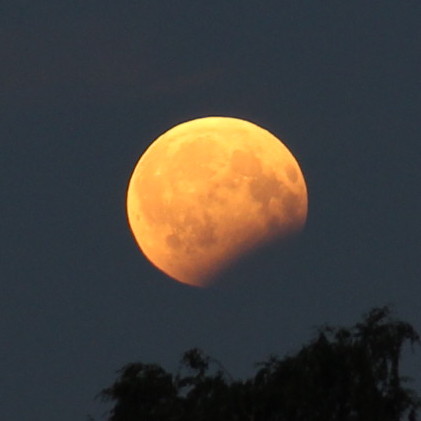
So the local times in Atlanta for the eclipse (albeit one that would have been below the horizon) would have occurred between 11:50 AM EDT (Eastern Daylight Time) and 4:50 PM EDT, with the maximum being at 2:20 PM EDT.
You said you set your time to 9:15 PM EST which would have a time after the eclipse. If you meant 9:15 PM EDT (because it was "Eastern Daylight Time" in Atlanta in August), but that still would have been a time after the eclipse had ended.
...So is it possible you did your UTC conversion incorrectly (adding 4 hours instead of subtracting 4 hours)?
That aside, you mentioned the size of the Moon in Stellarium is scaled down. However, I think (and I may be wrong about this) that the default size of the Moon in Stellarium is shown correctly (with a diameter of about 1/2 degree). I agree that it looks small, but I think that's only because our brains perceive it to be larger in the sky than it really is.
Did you ever take a picture of the Moon with your normal consumer camera or mobile phone camera without any zoom? If you did, you probably were disappointed that the Moon in the picture looked much smaller than it seemed in the sky:
Stock Picture of the Moon in the sky with normal lens; no zoom:
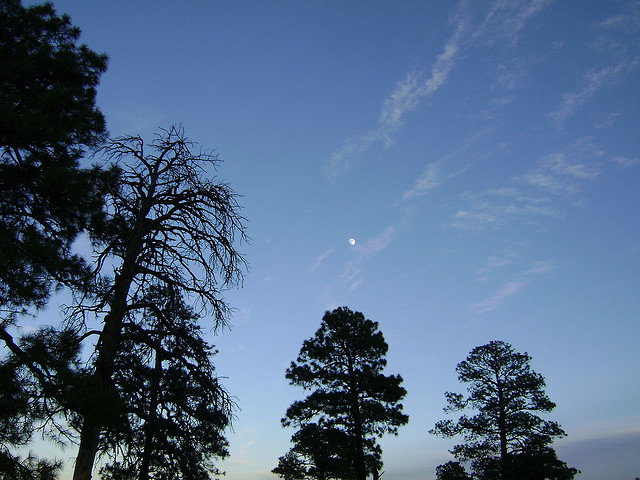
You can scale the Moon up in Stellarium to make it look larger, which I will do in the first image below that were taken from Stellarium on August 7, 2017 from Atlanta at 2:20 PM, with the ground turn off (because the Moon was below the horizon in Atlanta during the eclipse) and the atmosphere turned off (since this happened during daylight hours in Atlanta).
Here is an image from stellarium of the eclipse at maximum (14:20 EDT, local Atlanta time) with the Moon scaled up 4 times. You can see the eclipsed part of the Moon.
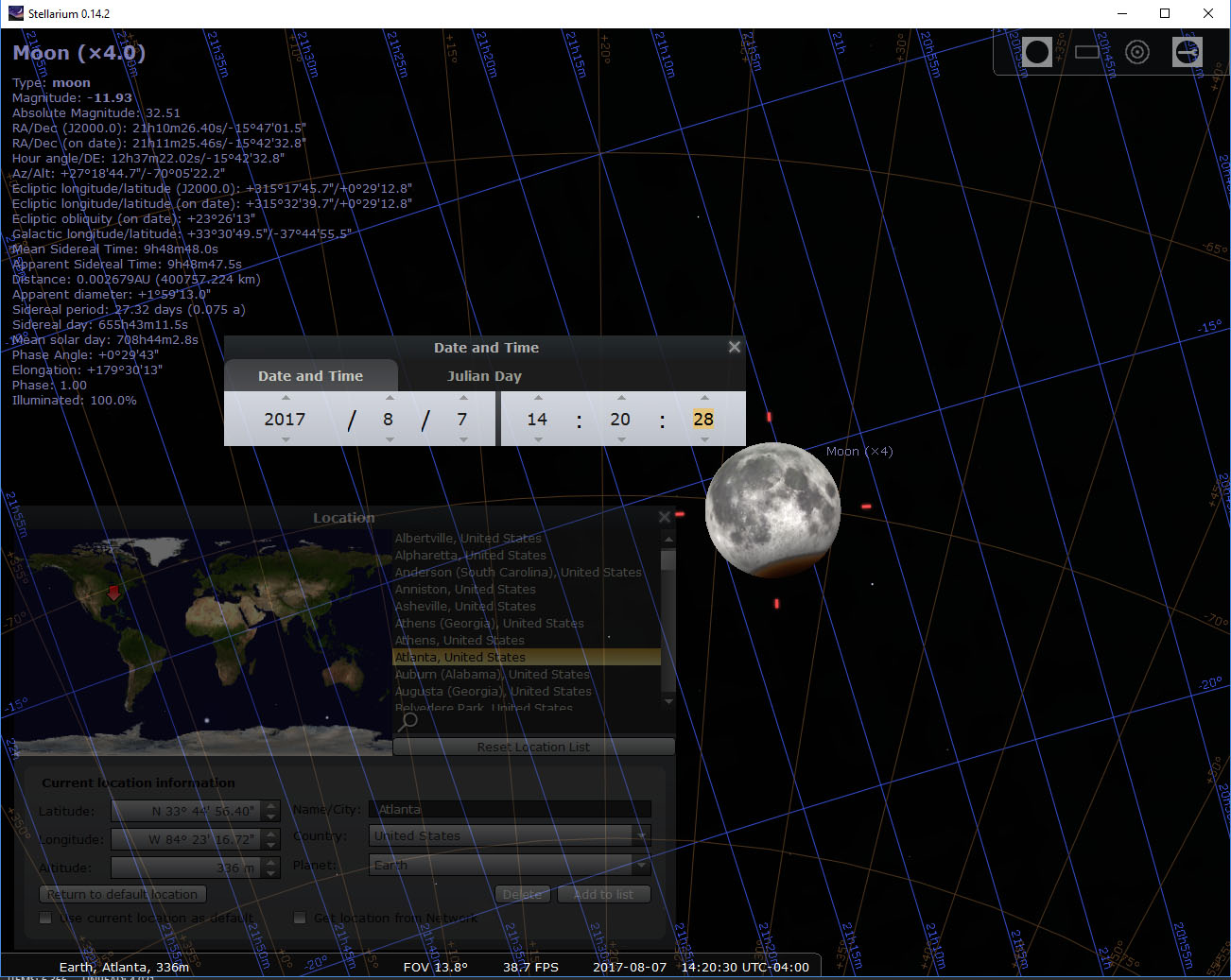
However, If I don't scale the Moon up, the eclipsed part is barely there. Here is the Moon NOT scaled up (at the default size that Stellarium shows) at the same time and location as the image above:
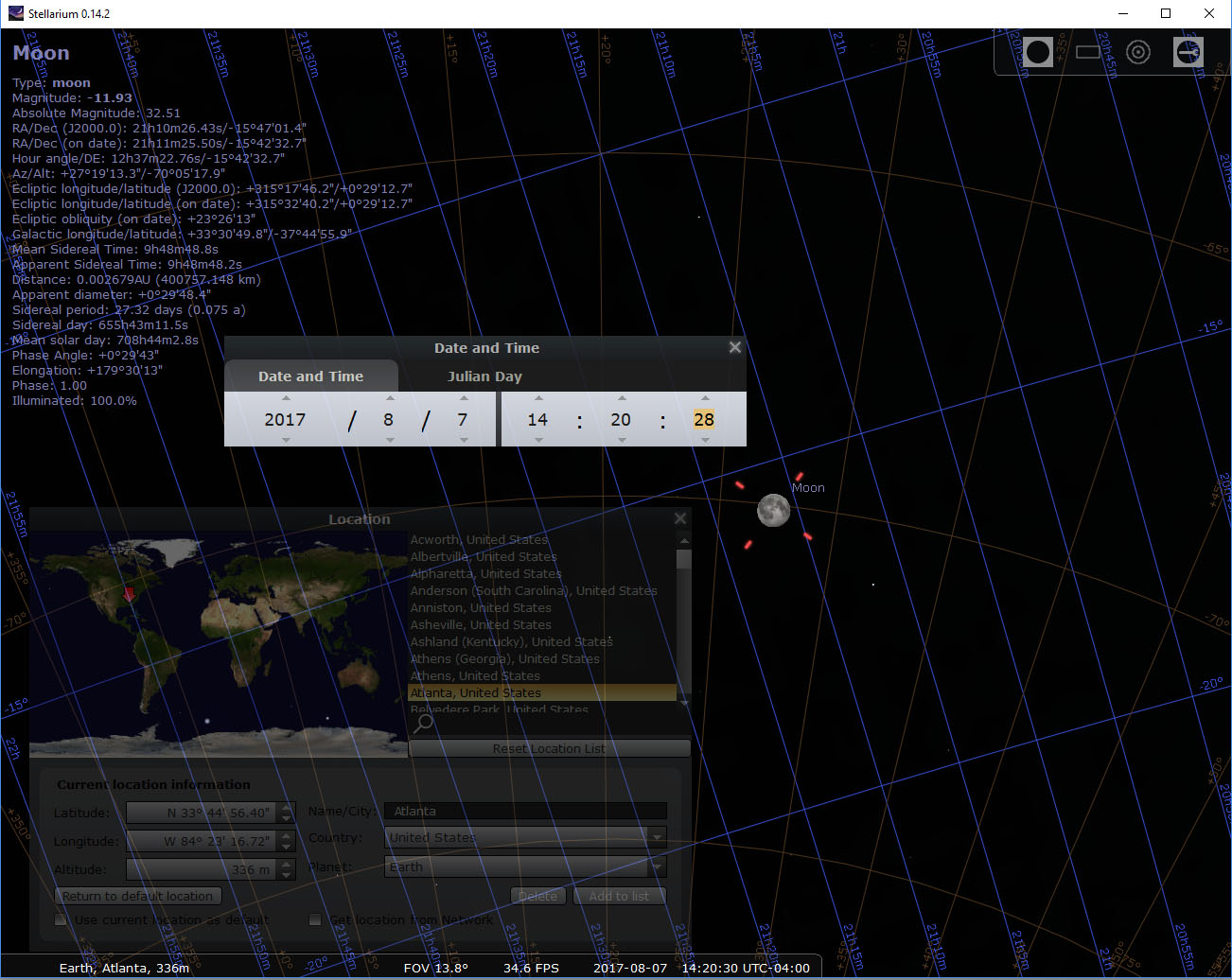
It's hard to see the shadow, but it becomes a little more visible if I zoom in closer. In the image below, you can barely make out a hint of a shadow at the lower right portion of the Moon:
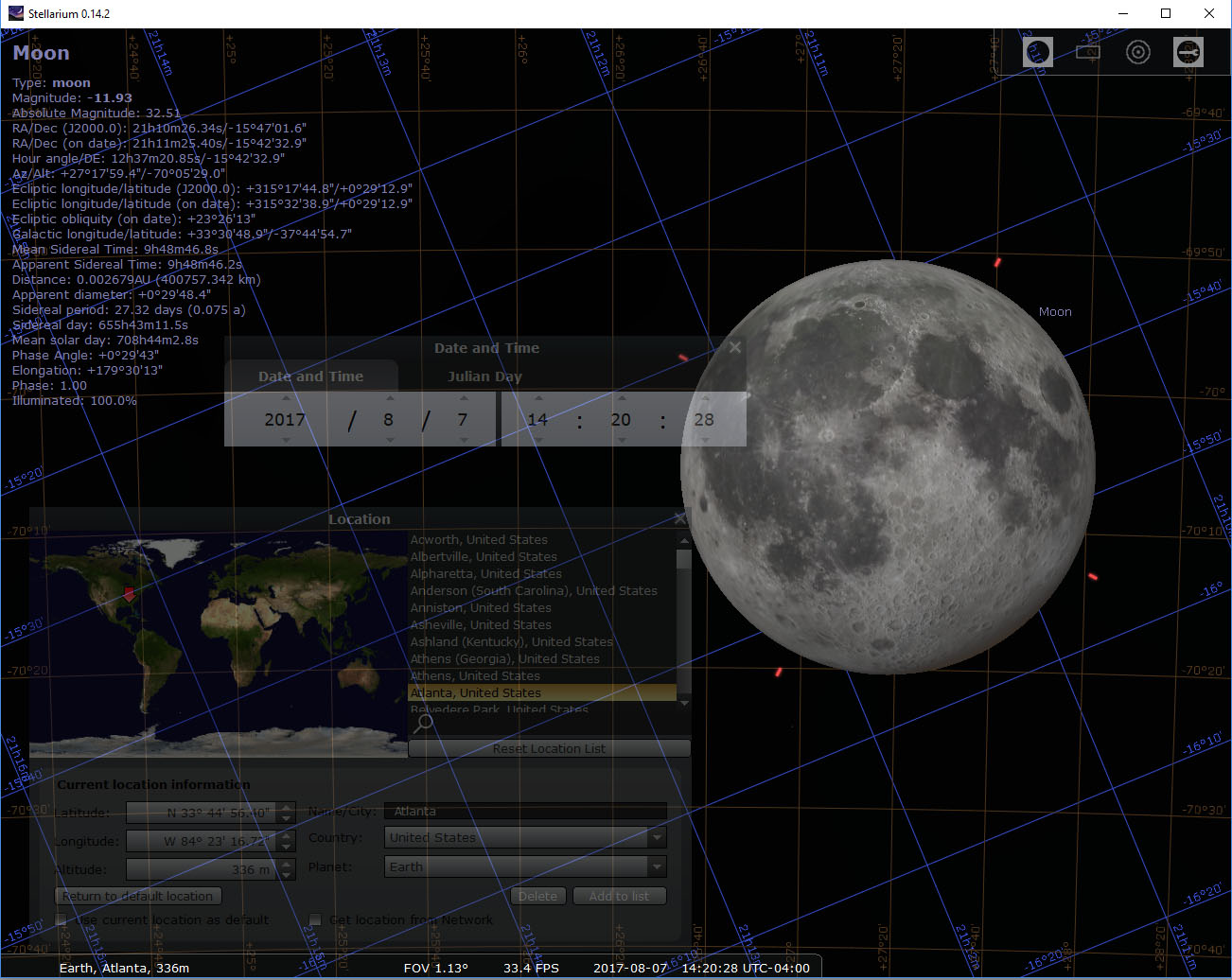
So the question becomes "why doesn't Stellarium show the lunar eclipse the way it looked in the sky". The answer to that might be (and I'm just speculating) due to the size of the Moon in Stellarium -- because the 4X-scaled Moon shows an eclipse that looks more like the pictures taken of the real eclipse.
HOWEVER...that goes against my earlier argument that I think the default Moon size is shown correctly in Stellarium.
So my short answer (after all that stuff I wrote above ) is...
"I don't know".
Source (Note: Link opens directly to a one-page PDF file)
it looked like this, as seen from Europe:

So the local times in Atlanta for the eclipse (albeit one that would have been below the horizon) would have occurred between 11:50 AM EDT (Eastern Daylight Time) and 4:50 PM EDT, with the maximum being at 2:20 PM EDT.
You said you set your time to 9:15 PM EST which would have a time after the eclipse. If you meant 9:15 PM EDT (because it was "Eastern Daylight Time" in Atlanta in August), but that still would have been a time after the eclipse had ended.
...So is it possible you did your UTC conversion incorrectly (adding 4 hours instead of subtracting 4 hours)?
That aside, you mentioned the size of the Moon in Stellarium is scaled down. However, I think (and I may be wrong about this) that the default size of the Moon in Stellarium is shown correctly (with a diameter of about 1/2 degree). I agree that it looks small, but I think that's only because our brains perceive it to be larger in the sky than it really is.
Did you ever take a picture of the Moon with your normal consumer camera or mobile phone camera without any zoom? If you did, you probably were disappointed that the Moon in the picture looked much smaller than it seemed in the sky:
Stock Picture of the Moon in the sky with normal lens; no zoom:

You can scale the Moon up in Stellarium to make it look larger, which I will do in the first image below that were taken from Stellarium on August 7, 2017 from Atlanta at 2:20 PM, with the ground turn off (because the Moon was below the horizon in Atlanta during the eclipse) and the atmosphere turned off (since this happened during daylight hours in Atlanta).
Here is an image from stellarium of the eclipse at maximum (14:20 EDT, local Atlanta time) with the Moon scaled up 4 times. You can see the eclipsed part of the Moon.

However, If I don't scale the Moon up, the eclipsed part is barely there. Here is the Moon NOT scaled up (at the default size that Stellarium shows) at the same time and location as the image above:

It's hard to see the shadow, but it becomes a little more visible if I zoom in closer. In the image below, you can barely make out a hint of a shadow at the lower right portion of the Moon:

So the question becomes "why doesn't Stellarium show the lunar eclipse the way it looked in the sky". The answer to that might be (and I'm just speculating) due to the size of the Moon in Stellarium -- because the 4X-scaled Moon shows an eclipse that looks more like the pictures taken of the real eclipse.
HOWEVER...that goes against my earlier argument that I think the default Moon size is shown correctly in Stellarium.
So my short answer (after all that stuff I wrote above ) is...
"I don't know".
edit on 6/11/2017 by Soylent Green Is People because: (no reason given)
a reply to: Soylent Green Is People
That could be my favorite EVER TL : DR even though I did read every word and also learnt A lot!!
Big thanks
That could be my favorite EVER TL : DR even though I did read every word and also learnt A lot!!
Big thanks
edit on 6-11-2017 by UpIsNowDown because: emoji
a reply to: Soylent Green Is People
No. You're misleading people by changing the time. Anyone can see this is what I said:
"I don't think posting pictures is nearly as beneficial as you downloading the Google Sky Map app and actually running the numbers yourself.
8-7-17 9:15 PM EST (as viewed from Atlanta) "
Instead of using my numbers you made a mistake and put the moon below horizon.
No. You're misleading people by changing the time. Anyone can see this is what I said:
"I don't think posting pictures is nearly as beneficial as you downloading the Google Sky Map app and actually running the numbers yourself.
8-7-17 9:15 PM EST (as viewed from Atlanta) "
Instead of using my numbers you made a mistake and put the moon below horizon.
edit on 7-11-2017 by apdjbs1 because: Precision
"originally posted by seattlerat:
What platform are you trying to find software for?"
If you can find any software on any platform that can match that ancient mechanism and show the rotation of the crescents I will send you $100 PayPal.
If you can find software that proves the ecliptical that happened on the time/location I said it did then I will also send $100 PayPal. (This excludes Google Sky Map, as I already proved it)
Ideally the platform would be Android or Win10 but if I can get someone else that can test then that's fine.
Keep in mind according to Wikipedia, in regards to ancient mechanism:
"Finally, mechanical engineer Michael Wright has demonstrated that there was a mechanism to supply the lunar phase in addition to the position.[45] The indicator was a small ball embedded in the lunar pointer, half-white and half-black, which rotated to show the phase (new, first quarter, half, third quarter, full, and back) graphically. The data to support this function is available given the sun and moon positions as angular rotations; essentially, it is the angle between the two, translated into the rotation of the ball."
Ignore the other posters whom distract. The reward is there. Rewrite the question in the appropriate forum if you like. This thread is likely already too papered over for anyone to follow.
What platform are you trying to find software for?"
If you can find any software on any platform that can match that ancient mechanism and show the rotation of the crescents I will send you $100 PayPal.
If you can find software that proves the ecliptical that happened on the time/location I said it did then I will also send $100 PayPal. (This excludes Google Sky Map, as I already proved it)
Ideally the platform would be Android or Win10 but if I can get someone else that can test then that's fine.
Keep in mind according to Wikipedia, in regards to ancient mechanism:
"Finally, mechanical engineer Michael Wright has demonstrated that there was a mechanism to supply the lunar phase in addition to the position.[45] The indicator was a small ball embedded in the lunar pointer, half-white and half-black, which rotated to show the phase (new, first quarter, half, third quarter, full, and back) graphically. The data to support this function is available given the sun and moon positions as angular rotations; essentially, it is the angle between the two, translated into the rotation of the ball."
Ignore the other posters whom distract. The reward is there. Rewrite the question in the appropriate forum if you like. This thread is likely already too papered over for anyone to follow.
edit on 7-11-2017 by apdjbs1 because: Added exclusion as reminder that I already know Google Maps shows it, although its cumbersome to
explain. I don't know why Stellarium kinks the ecliptical line and reduces proportional size of moon. I guess it's ATS.
a reply to: apdjbs1
Stellarium is accurate for whatever position on Earth you put as your location as for the Moon size that depends on the zoom setting which changes the field of view so if you know the feild of view angle of a camera lens or telescope you see what it would see.
As for your eclipse comment.
Stellarium is accurate for whatever position on Earth you put as your location as for the Moon size that depends on the zoom setting which changes the field of view so if you know the feild of view angle of a camera lens or telescope you see what it would see.
As for your eclipse comment.
While the Great American Eclipse is the one everyone in the United States is talking about, those living in the Europe, Africa, Asia and Australia had a show in the sky all their own.
So why didn’t the U.S. see the lunar eclipse? It actually took place while the Western Hemisphere was turned away from the moon and was in the height of day.
a reply to: apdjbs1
This may help people understand the size of the Moon/Sun in the frame of a photograph
Sun Moon size v Focal Length
or here
Sun Moon size v Focal Length
Thats for 35mm film or a full frame digital camera the first link gives 2 focal lengths for each image because the focal lentgh in blue is for APS-C or crop sensor cameras.
The human eye is closely matched by 45-50 mm focal length lenses (on full frame cameras)
Here is the Moon on my APS-C DSLR with a 70-300mm zoom first with a heavy crop
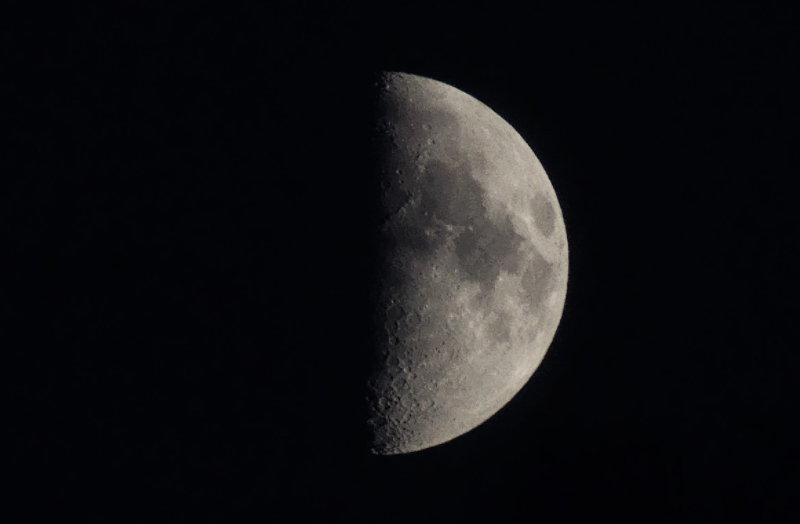
Now how it looked in the frame.
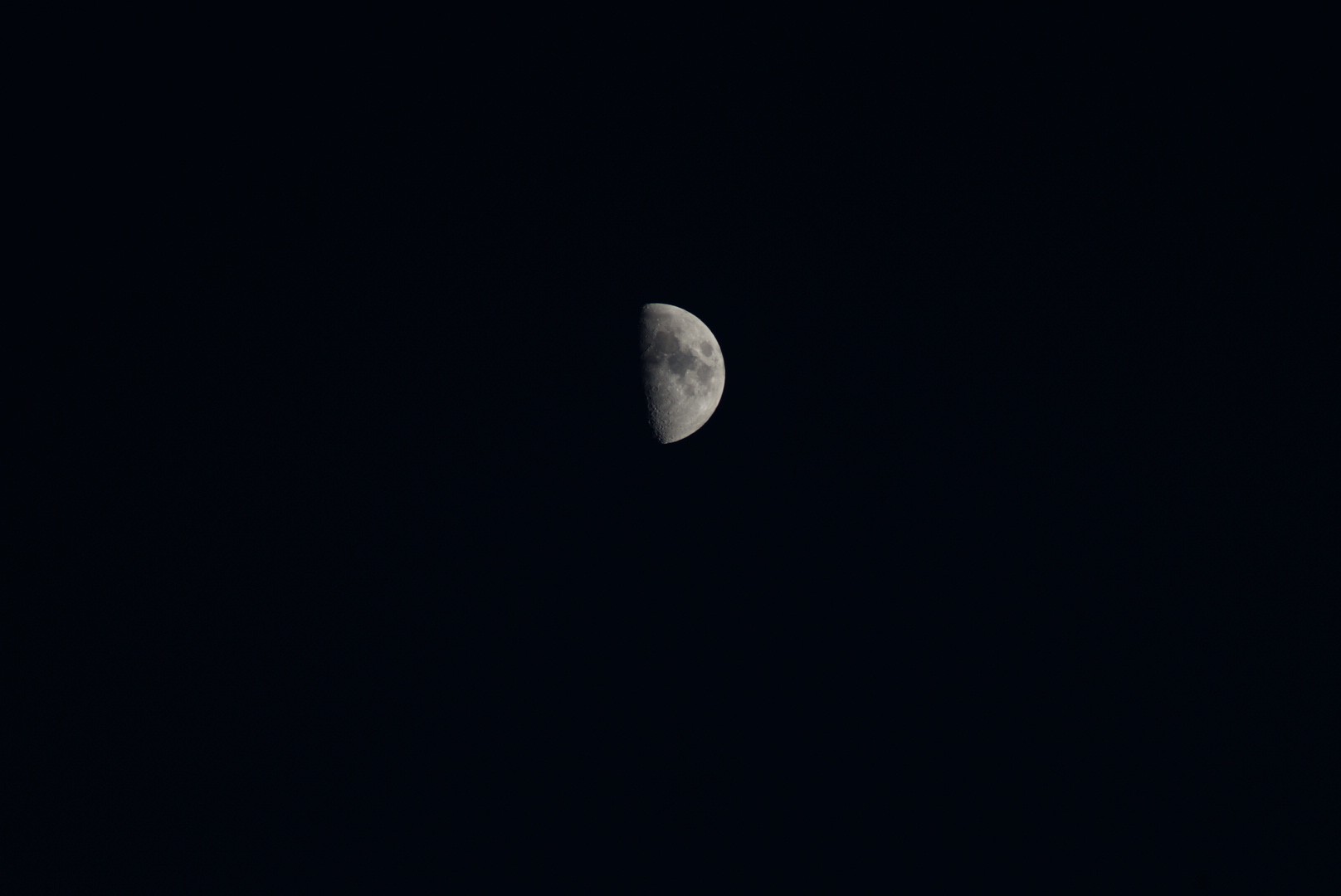
This may help people understand the size of the Moon/Sun in the frame of a photograph
Sun Moon size v Focal Length
or here
Sun Moon size v Focal Length
Thats for 35mm film or a full frame digital camera the first link gives 2 focal lengths for each image because the focal lentgh in blue is for APS-C or crop sensor cameras.
The human eye is closely matched by 45-50 mm focal length lenses (on full frame cameras)
Here is the Moon on my APS-C DSLR with a 70-300mm zoom first with a heavy crop

Now how it looked in the frame.

a reply to: apdjbs1
Do this in Stellarium select Moon centre it on the Moon so it always shows the Moon in the centre of your screen switch off the ground so that never shows fast forward the clock and watch the phases of the Moon change and the angle of the Moon.
Problem solved
Do this in Stellarium select Moon centre it on the Moon so it always shows the Moon in the centre of your screen switch off the ground so that never shows fast forward the clock and watch the phases of the Moon change and the angle of the Moon.
Problem solved
originally posted by: apdjbs1
a reply to: Soylent Green Is People
No. You're misleading people by changing the time. Anyone can see this is what I said:
"I don't think posting pictures is nearly as beneficial as you downloading the Google Sky Map app and actually running the numbers yourself.
8-7-17 9:15 PM EST (as viewed from Atlanta) "
Instead of using my numbers you made a mistake and put the moon below horizon.
But there was no eclipse to see on August 7 at 9:15 PM in Atlanta. There was an eclipse that occurred earlier that day, but it was already over by then. Also, when it was happening earlier that day, it was below the horizon from the viewpoint of Atlanta.
Using Atlanta local time, the eclipse would have occurred between 11:50 AM EDT (Eastern Daylight Time) and 4:50 PM EDT, with the maximum being at 2:20 PM EDT. You said you were looking for the eclipse in Stellarium with the time set to 9:15 PM in Atlanta.
The Moon may have just risen at 9:15 PM in Atlanta, but by that time the eclipse was already over, and had been for hours. Earlier in the day when the eclipse was occurring (between 11:50 AM and 4:50 PM local Atlanta time) the Moon would have still been below the horizon from the viewpoint of Atlanta.
Source for Eclipse Times
(Note: Link opens directly to a one-page PDF file)
edit on 8/11/2017 by Soylent Green Is People because: (no reason given)
Sigh... I guess this is how they knew they could get away with it.
Nobody is willing to take the effort to plug in my numbers into Google Sky Map and take a close look at the ecliptical line significantly cutting into the moon.
For an eclipse or partial eclipse to occur: it has to be a full moon phase (check, it was), and has to be above horizon (check, it was), and moon has to be cut by ecliptical (check, it was). The sun was exactly in line with the Earth/Moon as was also demonstrated by the eclipse seen on other side of Earth and remained as such as the Earth quickly rotates on axis and just a few hours later we (Atlanta anyway) saw the eclipse in reverse, with horns up rather than horns down.
It's complicated to us non-astronomers to figure out or explain. It happened and multiple people saw it when the high altitude clouds briefly moved. We discussed it in text message which is why I remember exact time. When it occurred I didn't realize we weren't suppose to see it. Long time later I see it was suppose to be a full moon that night and I got suspicious, and now here I am. It's impossible to discuss on internet I guess, but one day someone will figure this out.
Nobody is willing to take the effort to plug in my numbers into Google Sky Map and take a close look at the ecliptical line significantly cutting into the moon.
For an eclipse or partial eclipse to occur: it has to be a full moon phase (check, it was), and has to be above horizon (check, it was), and moon has to be cut by ecliptical (check, it was). The sun was exactly in line with the Earth/Moon as was also demonstrated by the eclipse seen on other side of Earth and remained as such as the Earth quickly rotates on axis and just a few hours later we (Atlanta anyway) saw the eclipse in reverse, with horns up rather than horns down.
It's complicated to us non-astronomers to figure out or explain. It happened and multiple people saw it when the high altitude clouds briefly moved. We discussed it in text message which is why I remember exact time. When it occurred I didn't realize we weren't suppose to see it. Long time later I see it was suppose to be a full moon that night and I got suspicious, and now here I am. It's impossible to discuss on internet I guess, but one day someone will figure this out.
originally posted by: apdjbs1
...For an eclipse or partial eclipse to occur: it has to be a full moon phase (check, it was), and has to be above horizon (check, it was), and moon has to be cut by ecliptical (check, it was). The sun was exactly in line with the Earth/Moon as was also demonstrated by the eclipse seen on other side of Earth and remained as such as the Earth quickly rotates on axis and just a few hours later we (Atlanta anyway) saw the eclipse in reverse, with horns up rather than horns down.
As you said, it is true that a lunar eclipse should occur when the Full moon crosses the ecliptic, HOWEVER...the Moon was no longer "officially" full at 9:15 PM local Atlanta time. The official Full phase happened at 2:12 PM local time -- about 7 hours earlier. That may seem like a short time since full, but that 7 hours is enough time to be the difference between the Earth's shadow falling upon the moon (producing an eclipse) and the Earth's shadow missing the Moon (no eclipse).
For a lunar eclipse to occur, the Sun needs to be at (or near enough) the opposite node where the Full Moon crosses the ecliptic. The Sun was in fact near enough to the opposite node in order for the partial lunar eclipse to occur early that day on the other side of the world (which occurred between on 15:50 UTC and 20:52 UTC on August 7).
However, by the time the Earth rotated around enough to be able to see the Moon rising in Atlanta at 9:15-ish local Atlanta time (01:15 UTC on August 8th), the Sun was no longer near enough to the opposite node in order to be properly aligned with the Earth-moon system in order to produce an eclipse.
By the way, here (the image below) is a Satellitium screen capture of the Moon as seen from Atlanta at from 9:15 PM (Atlanta time) on August 7, 2017 (01:15 August 8 UTC). As you can see, the ecliptic plane does not cross the Moon:

Now, here's where it gets a little complicated. Here (image below) is the Moon from the viewpoint of Atlanta 2 hours earlier at 7:15 PM (23:15 UTC). IT SHOULD BE NOTED...The Moon is below the horizon from the viewpoint from Atlanta at this time, so it would not have risen yet. I turned off the "ground" and the atmosphere so we can see the Moon.
As you can see, the ecliptic plane DOES cross into the Moon, so if the Moon were full, we would expect a partial eclipse. However, as I mentioned earlier, the Moon by this point was already a few hours past the official full phase, and those few hours make the difference as to whether or not the eclipse will occur. Granted, an eclipse can last for a few hours before and after the official full phase , but this was simply too long after being full -- thus no eclipse at that time:
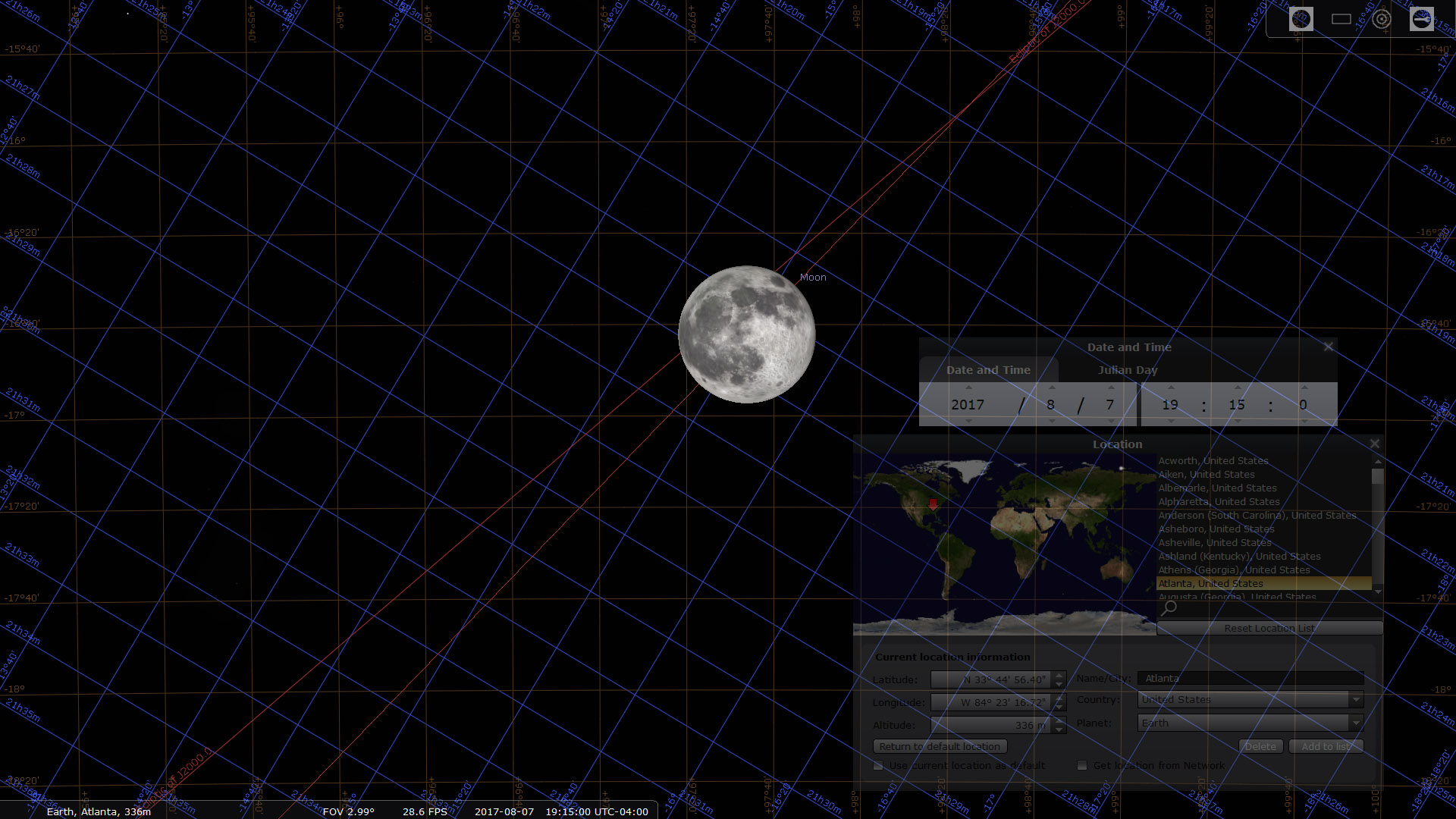
edit on 14/11/2017 by Soylent Green Is People because: (no reason given)
a reply to: Soylent Green Is People
Simple, compare that:
"By the way, here (the image below) is a Satellitium screen capture of the Moon as seen from Atlanta at from 9:15 PM (Atlanta time) on August 7, 2017 (01:15 August 8 UTC). As you can see, the ecliptic plane does not cross the Moon"
as compared to what I'm repeating: Google Sky Map. Because other apps bend their ecliptical to miss the moon, and/or make moon smaller to miss all but the most perfect eclipses.
Simple, compare that:
"By the way, here (the image below) is a Satellitium screen capture of the Moon as seen from Atlanta at from 9:15 PM (Atlanta time) on August 7, 2017 (01:15 August 8 UTC). As you can see, the ecliptic plane does not cross the Moon"
as compared to what I'm repeating: Google Sky Map. Because other apps bend their ecliptical to miss the moon, and/or make moon smaller to miss all but the most perfect eclipses.
originally posted by: apdjbs1
a reply to: Soylent Green Is People
Simple, compare that:
"By the way, here (the image below) is a Satellitium screen capture of the Moon as seen from Atlanta at from 9:15 PM (Atlanta time) on August 7, 2017 (01:15 August 8 UTC). As you can see, the ecliptic plane does not cross the Moon"
as compared to what I'm repeating: Google Sky Map. Because other apps bend their ecliptical to miss the moon, and/or make moon smaller to miss all but the most perfect eclipses.
Stellarium's default size for the Moon (which is what I'm showing in the images above) shows the Moon at the right size -- which is about 0.5 degrees in diameter.
Having said that, I'm not sure what your point is. My point is that the lunar eclipse was already over when the Moon was rising in Atlanta at 9:15 PM Atlanta time.
By the way , your thread title says "9:15 PM EST", but In August, Atlanta would have been in EDT (Daylight Time), not EST. That possibly may be another factor in my Stellarium looking different than your Google sky -- i.e., your 9:15 and my 9:15 might be an hour apart. I'm not saying that is the case, but you should confirm it.
Back to the eclipse...
The last of the eclipse on August 7 and 8 could be seen in Spain and Portugal (and people in the East Atlantic Ocean) that night at around 19:00 to 20:00 UTC, a little past moonrise at those places. They could watch as the last of the Earth's shadow slipped off of the Moon, until there was no more shadow (at least no umbra).
THAT disappearance of the shadow marking the end of the eclipse occurred well before the Moon rose in Atlanta. By the time the Moon rose in Atlanta a few hours later, the Earth's shadow no longer fell upon the Moon.
For the eclipse to be seen from Atlanta, the shadow of the Earth (that people in Portugal saw leave the Moon hours earlier) would have needed to magically reappear on the Moon again as it rose in Atlanta. That could not happen.
Like I said, the reason the Moon no longer had the earth's shadow falling upon it when it rose in Atlanta was that the Full Moon had occurred 7 hours earlier; the Moon was 7 hours past full at 9:15 PM in Atlanta. A partial lunar eclipse such as this can continue for a couple of hours after the official time of fullness, but it would NOT last for seven hours after official time of fullness.
edit on 14/11/2017 by Soylent Green Is People because: (no reason given)
a reply to: Soylent Green Is People
Thank you for pointing out that it was 9:15PM EDaylightT and not Eastern"Standard"Time.
Very tricky stuff so attention to detail is important.
My turn to correct you again... So if you're admitting it was a full moon in Atlanta at 2, then just apply the math from the following statement and you can easily get the extra hours needed especially if you add in the extra penumbra time:
"Each partial (lunar eclipse)phase consumes at least one hour, and totality can last as long as one hour and 40 minutes".
Bare in mind "totality" doesn't have to exist in the perfect sense, as you can easily envision a shadow falling on the bottom right part, then covering most of the side, and later on over the top. Still would be the same time. So if it can be in "totality" in the perfect sense for 1hr and40min then I think most people would find it not so hard to believe that 7hrs after shadow was on bottom edge that it would then be leaving the top edge of the moon. That's what we saw, and that's what Google Sky Maps indicates.
Thank you for pointing out that it was 9:15PM EDaylightT and not Eastern"Standard"Time.
Very tricky stuff so attention to detail is important.
My turn to correct you again... So if you're admitting it was a full moon in Atlanta at 2, then just apply the math from the following statement and you can easily get the extra hours needed especially if you add in the extra penumbra time:
"Each partial (lunar eclipse)phase consumes at least one hour, and totality can last as long as one hour and 40 minutes".
Bare in mind "totality" doesn't have to exist in the perfect sense, as you can easily envision a shadow falling on the bottom right part, then covering most of the side, and later on over the top. Still would be the same time. So if it can be in "totality" in the perfect sense for 1hr and40min then I think most people would find it not so hard to believe that 7hrs after shadow was on bottom edge that it would then be leaving the top edge of the moon. That's what we saw, and that's what Google Sky Maps indicates.
edit on 14-11-2017 by apdjbs1 because: (no reason given)
new topics
-
Former DOJ charged with defrauding Rep. Matt Gaetz’s family over sex-crimes investigation
Propaganda Mill: 1 hours ago
top topics
-
The mysterious death of Aileen Conway
General Chit Chat: 16 hours ago, 6 flags -
Swedish Minister for Gender Equality is Seeking Treatment for Phobia of Bananas
Other Current Events: 12 hours ago, 6 flags -
Former DOJ charged with defrauding Rep. Matt Gaetz’s family over sex-crimes investigation
Propaganda Mill: 1 hours ago, 4 flags -
USA-BIDEN and CHINA-Xi Agree Not To Let Artificial Intelligence Decide Nuclear Weapons Use.
World War Three: 13 hours ago, 3 flags -
Satanic ‘Little Season’ of Deception.. Awaken to the Handiwork of the Creator.
ATS Skunk Works: 13 hours ago, 3 flags
active topics
-
Former DOJ charged with defrauding Rep. Matt Gaetz’s family over sex-crimes investigation
Propaganda Mill • 4 • : fringeofthefringe -
I’m Looking for Information on the Light We See at Death.
The Gray Area • 65 • : whereislogic -
President-elect TRUMP Picks MATT GAETZ for his ATTORNEY GENERAL - High Level PANIC Ensues.
2024 Elections • 94 • : RickinVa -
The art of being offended
Social Issues and Civil Unrest • 53 • : andy06shake -
Swedish Minister for Gender Equality is Seeking Treatment for Phobia of Bananas
Other Current Events • 8 • : bluemooone44 -
How can you defend yourself when the police will not tell you what you did?
Posse Comitatus • 96 • : andy06shake -
Satanic ‘Little Season’ of Deception.. Awaken to the Handiwork of the Creator.
ATS Skunk Works • 6 • : YouSir -
The mysterious death of Aileen Conway
General Chit Chat • 11 • : Shoshanna -
Russia Ukraine Update Thread - part 3
World War Three • 6815 • : Freeborn -
Bucks County commissioners vote to count illegal ballots in Pennsylvania recount
2024 Elections • 22 • : Enduro
